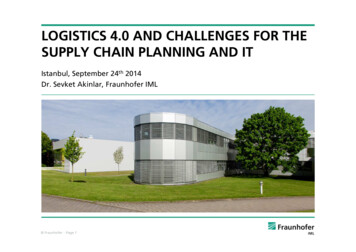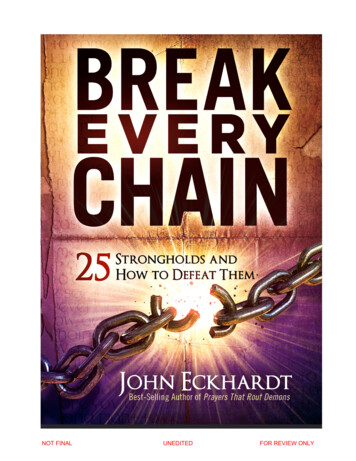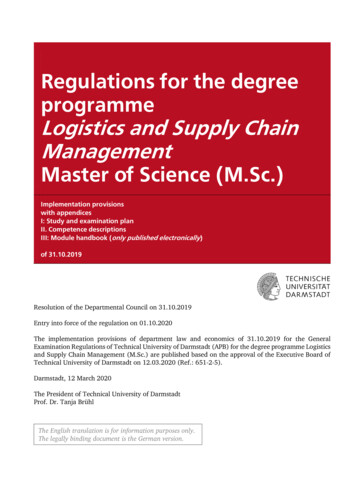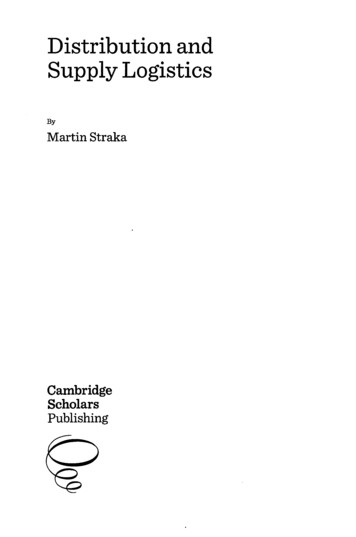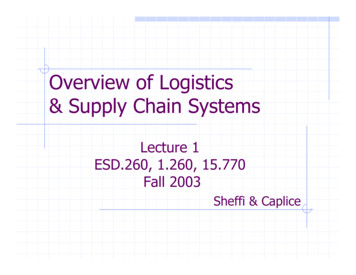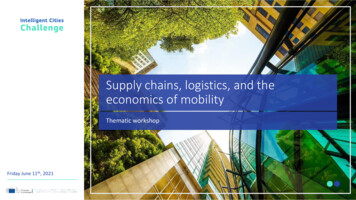
Transcription
Supply chains, logistics, and theeconomics of mobilityThematic workshopFriday June 11th, 2021
Welcome to the thematic workshop on supply chains, logistics, and theeconomics of mobilityPaola ChiariniDominic PapaChris de VeerTim VervoortElisa TorricelliPolicy OfficerVice President ofSmart State InitiativesStrategic AdvisorSmart MobilityConsultant Modal ShiftProject OfficerArizona CommerceAuthorityProvince of NorthHolland, MetropolitanArea AmsterdamCity of AntwerpCity of MilanEuropean Commission,DG MOVEStephanie HaagLuca MilaniAnja HuberAssociate PartnerAssociate PartnerAssociate PartnerMcKinsey & CompanyMcKinsey & CompanyMcKinsey & CompanyMunich, GermanyMilan, ItalyMunich, GermanyThe plenary sessions will be recorded - please turn off your camera if you do not want to be recorded2
Our Agenda anie HaagThematic Network Coordinator, McKinsey13:35-13:45Remarks by DG MOVEPaola ChiariniPolicy officer, EC, DG MOVE13:45-14:20Topic 1: Urban mobilityLuca MilaniThemative Netowkr Coordinator, McKinseyDominic PapaVice President of Smart State Initiatives, ArizonaCommerce Authority (ACA)Chris de VeerStrategic Advisor Smart Mobility, Province ofNorth Holland, Metropolitan Area AmsterdamAnja HuberThematic Network Coordinator, McKinseyTim VervoortConsultant Modal Shift, City of AntwerpElisa torricelliProject Officer, City of MilanStephanie HaagThematic Network Coordinator, McKinsey14:20-14:5514:55-15:00Topic 2: Freight andindustrial transportClosing remarks3
WelcomeStephanie HaagMcKinsey & Company
Sustainable urban mobility andlogistics: DG MOVE’s main policiesand initiatives relevant to citiesPaola ChiariniPolicy Officer, European Commission,DG MOVE
61Sustainable and Smart Mobility Strategy2New Urban Mobility Framework3Research and innovation opportunities4Digitalisation of freight transport
1 Sustainable and Smart Mobility StrategyObjective1SustainableMobilityAN IRREVERSIBLE SHIFT TOZERO-EMISSION MOBILITY7Objective2SmartMobilityACHIEVING SEAMLESS, SAFEAND EFFICIENT CONNECTIVITY90 % reduction in transportemissions;Seamless multimodal transportbased on digital solutions;All transport modes are mademore sustainable;Unleash full potential of data;Sustainable alternatives are available;Develop and deploy connected, cooperative,and automated mobility services;Right incentives are in place forsustainable choicesPaperless freight transport in favour of fast,digital procedures.Objective3ResilientMobilityA MORE RESILIENT SINGLE EUROPEANTRANSPORT AREA: FOR INCLUSIVECONNECTIVITYReinforced Single Market:- more investment in infrastructure andfleets;- deepening and enforcing internal market;- making our system crisis proof.Fair and just mobility (that is affordableand accessible);Enhanced safety and security.
Urban mobility and logistics in the StrategyFLAGSHIP 3 – Making interurban and urban mobility more sustainable and healthyFLAGSHIP 4 – Greening freight transportIncreasing modal sharesof collective transport,walking and cycling, aswell as automated, connected andmultimodal mobility willsignificantly lower pollution andcongestion.Multimodal logisticsmust be part of thistransformation. SUMPsshould also include the freightdimension through dedicatedsustainable urban logistics plans, toaccelerate the deployment of zeroemission solutions already available,including cargo bikes, automateddeliveries and drones and better useof inland waterways into cities.Engaging with cities toensure that all large andmedium-sized cities thatare urban nodes on the TEN-Tnetwork put in place their ownsustainable urban mobility plans(SUMPs) by 2030.Boosting the uptake ofzero-emission vehicles incorporate and urbanfleets.In addition, the European GreenDeal calls for a substantial part ofthe 75% of inland freight carriedtoday by road to shift to rail andinland waterways.Active transport modes,such as cycling, haveseen growth with citiesannouncing over 2300 km of extracycling infrastructure. This shouldbe doubled in the next decadetowards 5000 km in safe bike lanes.Clearer guidance is neededon mobility managementat local and regional level,including on better urban planning,and on connectivity with rural andsuburban areas, so that commutersare given sustainable mobilityoptions.Helping cities modernisetheir policy toolbox,including in areas such asmicromobility, support for theprocurement of zero-emissionvehicles, including buses and ferries,and associated infrastructure.Pricing carbonthe Commission plans toestablish a Europeanframework for the harmonisedmeasurement of transport andlogistics greenhouse gas emissions
2 New Urban Mobility FrameworkWhenWhy Need for a more coordinatedapproach, esp. in areas where EUaction can contribute the most To reinforce the support toEuropean cities for tackling urbanmobility challengesWhat9 Sustainable Urban Mobility Plansguidance on urban logistics and UVARurban Intelligent Transport Systemsdata and indicators (SUMI)urban road safetyand more Roadmap published in April Adoption planned by end2021How Five consultation workshops forstakeholders in June Urban logistics consultationworkshop on 21 June 12-week Open Public Consultation– imminent launch – see@Transport EU or DG MOVEwebsite
Urban freight transport and logistics in UMFWHY? Objective: Support cities in achieving carbon-neutral logistics, focusing on TEN-T urban nodesTarget in the Communication (tbc): reaching zero emission delivery in urban nodes (above 100 000 inhabitants) by 2030/ aim for 2040 in other (medium/bigger) EU citiesWHAT? Tentative content of the proposalHOW? Support the uptake of Sustainable Urban Logistics Plans (SULPs) Support the development of multimodal (micro)consolidation centres /freight routes to facilitate esp. the first/last mile logistics and connect tothe long haul cargo networks (TEN-T)In the Urban Mobility FrameworkCommunication In TEN-T revised regulation: Urbannodes 100 000 on TEN-T adopt adedicated urban logistics plan (SULP) ( recommend for other cities) In funding programmes, e.g. ESIF,Horizon Europe, Connecting EuropeFacility In actions planned in the Green Cargoflagship In DG CLIMA: internationalisation ofexternal costs Improve urban logistics data provision (loading zones/multimodal urbanfreight network/routing optimisation) Raise the need to standardise data exchange with (big) platforms onurban supply chain to facilitate groupage of (e-commerce) deliveries Accelerate the uptake of new/innovative delivery methods (cargobikes, LEFVs, drones etc.) and business/operating models to green thelast mile
3 Freight transport and logistics researchand innovation opportunities11
Co-creating urban mobilityin neighbourhoods (RIAs)CIVITAS SATELLITE (CSA)Urban freight andlogistics (RIAs)CITYLAB, NOVELOG,SUCCESS, U-TURNElectromobility andelectrification of PT (RIAs)ELIPTICEBSF 2Electric two-wheelersand new ultra-lightvehicle concepts (RIAs)ESPRITEU-LIVESustainable UrbanMobility Planning SUMP projects (RIAs)PROSPERITYSUMPsUpSUITSElectric vehiclesintegration into thetransport system andthe grid (RIAs)ELECTRIFICMulti-modal inter-urbantransport, regional mobility (RIAs)MOMENTUM, SproutSUMP-PLUS, ReVEaLThe impacts of newtechnologies and changes onpolicy making (RIAs)Take-up of innovativetransport and mobilitysolutions (IAs)HANDSHAKE,CityChangerCargoBike,Park4SUMPSmart electric mobility incities (IAs)MEISTERGreenChargeDemonstration for integrationof electrified vehicles in theurban transport system (IAs)ASSURED, ELVITENSTEVEEN-UACHARMONYERA-NET accessibilityin urbanLEAD, SENATORUlaaDsShared and low emissionlogistics operations in urbanareas (RIAs)CIVITAS ELEVATE (CSA)Road/street(re)design (RIAs)MORESocio-economic aspects oftransport: VTR, TPaccessibility, women intransport, vulnerable groupsaccessibility (RIAs)SKILFULL, Hi-Reach,Inclusion, STARs, MoTiv,GECKO, DIAMOND,TinnGo, TRIPS, INDIMO2019 - 2022/2023CIVITAS DemoActions/ Living Labs (IAs)Cities4People,Metamorphosis,SUNRISE, MUV2017/2018 - 2020/2021Tackling Congestion(RIAs)DESTINATIONS,ECCENTRIC,PORTIS2016 -2019/2020CREATE, CIPTEC,EMPOWER,FLOW, TRACE2015 - 2018Urban mobility and logistics in Horizon 2020Urban mobility andsustainable electrification inlarge urban areas InCo (IAs)SOLUTIONSPlusART is urban context (IAs)AVENUESHOWCIVITAS.EU
Freight transport and logistics R&I in HorizonEuropeMission “Climate-neutral and SmartCities”Work programme 2021-2022 topics:a strategic priority for joint action: “100 climateneutral cities by 2030”Sustainable and smart freighttransport and logistics Pilot actions on multimodal nodes andlogistics networks integration Resilient logistics networks Smart enforcement in road transport[to be adopted towards end 2021]Innovative urban logistics andmobility Greening the last mile Planning: anticipating demand,digitalisation Work programme 2021-2022 calls tobe open and published around midJune in Funding & Tender portal European R&I Days on 23-24 June Cluster 5 (Climate, Energy & Mobility)work programme 2021-2022 InfoDayand Brokerage event on 5-7 July
4 Digital Transport and Logistics ForumExpert Group of the Commission Mission: to provide a platform for structural dialogue, exchange and provision of technicalexpertise, cooperation and coordination between the Commission, Member States and industry Established in 2015, more than 100 members 2 work streams:1. Electronic freight transport information regulation (eFTI) – implementation ongoing, fullyapplicable in 2025 legal framework for the electronic B2A communication of existing regulatory information oncargo (but not vehicles or drivers) common data model, requirements for data processing and interfaces, obligation toauthorities to accept the information provided by any certified eFTI platform2. Trusted environment for corridor data exchange A proposal on a technical, organisational and legal framework and governance structure forcost effective and secure B2B data exchange to support collaborative logistics (architectureand rules for bringing together various exiting platforms – a logistics common data space)14
Thank youPaola ChiariniPaola.Chiarini@ec.europa.eu European Union 2020Unless otherwise noted the reuse of this presentation is authorised under the CC BY 4.0 license
Urban MobilityTopic 1
Trends disrupting Urban MobilityLuca MilaniAssociate Partner,McKinsey & Company
The main trends that are impacting and impacting the mobility sectorover the next 10 yearsMedium termShort termConsumersDescriptionProgressive diffusion / use of shared mobilitysystems perceived as more sustainableGrowth of micro-mobility systems (e.g. e-scooters,electric scooters) and related ancillary services offeredby municipalities/ transport operators150Growing demand for customer customization of theoffer of products and services50% Customer interactions that willbe customized by 2024 throughdigital channels and physicalstores1.5x impact of e-commerce on globalpurchases by 2024Digitization/InnovationIncreasing fragmentation of purchases through ecommerce, with significant impacts on first/ last miletransport and urban logistics flowsRegulatory andmarketenvironmentEvidence9 growth per year on shared% mobility by 2030Growing deployment of Mobility-as-a-Serviceplatforms and use of sensors and connected devicesto provide live mobility informationEstablishment of funds at European level (e.g. EUnext generation fund) and at national level to supportthe TPL sector limited to initiatives with a strongsustainability footprint (e.g., financing or only forelectric and non-hybrid buses)-90%Evidence1,5annual growth age group 64 %years in Italy between 2019-2030(vs.-0.1% at country level)Potential deployment of self-driving vehicles dueto lower transport costs for the final consumer (e.g.,robotaxi) and increased safety (autonomousprivate cars)-50% reduction of transport coststhrough autonomous TPL for theconsumerGrowing demand for technology from citizens andprogressive development of "smart" applications invarious sectors of the urban ecosystem80% Italians who rely on smart citysolutions to improve liveability intheir citiesGrowing electric vehicle deployment supported byincreased investment in R&D for electric andhydrogen technology development33% penetration of new registrationsof private electric vehicles in Italyby 2030Increased competition in the TPL market withpotential entry of international players into theItalian TPL60 Races in Italy in the coming yearsEUR billion as the market value ofmicro-mobility in Europe55 billion connected devices by2025750DescriptionProgressive ageing of the population, combinedwith a reduction in spending capacityEUR billion guaranteed by theRecovery Fund at European level( EUR 210 billion to Italy)reduction of greenhouse gasemissions from means oftransport by 2050 in Italy18
5 different concepts are key to sustainable, urban new mobility and zeroemission areasDetailed nextSELECTED EXAMPLES ONLYPeople transportGoods transport1E-Mobility andcharginginfrastructureConsumer incentives & TCOHome chargingPublic charging networkNew business models (e.g., batteryswaps)Fleet incentives & TCOYard charging2Seamless mobilityMicro-mobilityCar sharing, e-hailingMulti-modal mobility/hubsIntegrated people/goods transport(e.g., goods tram)Urban consolidation centers,cargo bikes etc.Cargo/freight sharing3Autonomous mobilityRobo taxis4Smart, dynamic trafficmgmt. & connectedinfrastructureSmart and shared mobilityDynamic road pricingSmart parking / dynamic curb mgmtIntelligent traffic systems (ITS)Urban space re-design5Data management &platformData standards and sharingAutonomous ground vehicles(on street transport)Droids (pavement)19
I: The growing demand for technology from citizens and publicadministrations will lead to a progressive 'smartification' of citiesExamples of services offered relating to city mobility60%Penetration ofsmart home devicesin Italy80% Italians rely onsmart city solutionsto increase theliveability oftheir citiesSmartsurveillanceSmart video surveillance systems withdedicated platform and video-analysissoftwareSmart parkingSmart parking platform with parkingbooking and verification softwareSmart mobilitySystem and platform for themanagement of ZTL and light signs(e.g. green waves) for traffic regulationClimate changeresilienceMonitoring and prevention systems forpublic infrastructure and risk areas (e.g.bridges, viaducts, roads)Implications for .Identify and evaluateoptions for thedevelopment of smartsolutions for urbanmobility by leveragingthe "infrastructure user" connectionthrough the use of dataand technology (e.g.creation of platforms forthe centralization ofservices to citizens; smartparking solutions; trafficcontrol systems)Source: McKinsey20
Opportunities to enhance transportation, equity and economic outcomesacross the cityPRELIMINARY, PROPRIETARY, PRE-DECISIONAL NON-EXHAUSTIVEChallenge1OpportunitiesReaffirm commitment to transit solutions androbust mix of mobility optionsDetailsBest practicesA Increase integration and agility of existing networks for long-term sustainabilityand financial viabilityB View long-term transit health as integrated with land use solutions that increasedensity, affordability, and access to transit23Increase supply of mobility solutions in connectionwith managing congestion and demand throughpricingAdopt new regulations, uses, and pricing schemeC Adopt mobility solutions based on dynamic pricingD Invest in streetscape to support walking, cycling-, and micro-mobilityEDevelop employer-back transit solutionsFDynamically price on-street parking to reduce congestion and raise revenuesG Facilitate technological solutions to improve delivery management45Close equity gaps through new mobility options(e.g., microtransit) and target traditional fixed-routehigh-frequency routes targeting transit “deserts”Adopt comprehensive Vision Zero goals to enhancesafety outcomesH Provide subsidies for low-income residents for transit usageILeverage microtransit or ride-sharing partnerships for new routesJReview and redesign traditional fixed-route high-frequency routes targetingunderserved communitesK Fastrack Vision Zero initiatives (e.g., District-wide reduction of speed limits,streetscape redesigns)21
Mobility development depending on the measures, and their impactWe see multiple examples how cities are compensating this shift to keepbalance between public and private transportTypes of influenceon the choice of transportCost of travelPrivate carsPublictransportTravel timeComfortSafety (COVID-19)Private s to beassessed inthe modelDowntown parking ratechangeExamples of measures in the cities (news date)Dresden: To promote the use of public transport, they for the first time in 14 years raised the parking ratetwofold (from EUR 1.5 to EUR 3 per hour) in the central area and fourfold (by EUR 0.5 to EUR 2 per hour) inthe rest of the city, the day rate (fixed price for 24 hours of parking, which used to be EUR 6) is cancelled inthe central areaSeptember 2020London: The parking rate is raised by 30% (from GBP 5.2 to GBP 6.72 for 30 min) in Croydon business areaMay 2020Reduction of publictransport fares outside ofpeak hoursSingapore: On weekdays until 7:45 the Mass Rapid Transit (MRT) and Light Rail Transit (LRT) fare is reducedby 28% (from SGD 1.76 to SGD 1.26)May 2020Moscow: Moscow Metro introduced fare discounts up to 50% on 2 lines for passengers who entered metrostations from opening to 7:15 and 8:45 to 9:15November 2020Additional priority lanes forpublic transport and taxiMadrid: In 2020, they launched 138 ( 21%) new bus lanes (797 in total)New York: They launched 32 km ( 17%) of new bus lanes to serve 750,000 passengers per dayAugust 2020Zonal speed limits forprivate carsParis: Since 2021, they plan to switch to full limitation of speed to 30 km/h in most streets, in 2020 this hasalready been done in central districtsOctober 2020Madrid: 30 km/h limit is introduced in more than 80% of city streetsNovember 2020London: The mayor has launched the Streetspace Program to increase bicycle travel 10-fold and pedestriantravel 5-foldMay 2020Milan: 35 kilometers of motor roads will be converted to bicycle roadsApril 2020Paris: 1. Pilot project: In the buses of one line, they installed touchless request buttons for door opening andstops2. During a lockdown, travel by public transport in peak hours is allowed only to those who have acertificate issued by their employerOctober 2020New York: They launched a mobile app for tracking bus crowding in real timeJuly 2020Promotion of activemovementSafer travel by publictransport (disinfection, PPEchecks, etc.)May 202022
Arizona & P3 Efforts for MobilityInnovationDominic PapaVice President of Smart StateInitiatives, Arizona CommerceAuthority
JUSTHOWMUCHMONEY The global CAVmarket isestimated toreach USD 60Bby 2030 or USD557B by 2026Business Wire/Allied MarketResearchDiagram Source: DeloitteInsights, “Forces of change: Thefuture of mobility”
VIBRANT CAV ECOSYSTEM
Provide the technical guidance and coordination required to ensure the prudent implementation of safe, efficient automatedmobility across Arizona.IndustryGovernmentResearch
Deployautomation to significantly increase roadway safetyTechnicalFocusCurrent Safety Projects:Safety OSA Metrics Definition and Measurement Naturalistic Driving Analysis State-wide Camera Network Data AnalysisProjects in the pipeline: Smart Road Side Unit (RSU): Collaboration between Intel, ADOT, UArizona, Cohda, McDOT and ADOT to develop a 5G-based RSU . Project lays the foundation for the future of smartintersections, utilizes AI based vision analytics, C-V2X communications and edge computing to enhance safety and positions IAM as a center of excellence and innovation hub for newstartups. Operational Safety Assessment (OSA) Testbed: Collaboration between Exponent, Luminar, ASU, McDOT and ADOT to develop a controlled testing site for high conflict scenarios e.g. nearmisses and crashes. The project builds on the real world data collection work underway at the Anthem testbed and furthers the objectives outlined in the IAM executive order todevelop a network of testing capabilities. Vehicle and Driver Data-Gathering Infrastructure: Collaboration between UArizona, ADOT and McDOT to deploy a unique data collection system of driver and vehicle interaction datafrom fleets of L1 automation and Advanced Driver Assistance System (ADAS) equipped vehicles. The project leverages data analysis, machine learning and artificial intelligence toproduce a novel Arizona centric dataset for new breakthroughs in mobility and transportation and guide new infrastructure investments. AV Perception Redundancy Assessment and Validation: Collaboration between Intel and UArizona to validate AV perception systems by developing a methodology to explore impact ofdual perception systems redundancy. The project offers the potential to design a groundbreaking means to independently “vision test” AVs and address a critical missing element ofAV safety assessment not yet addressed by industry. Automated Traffic Incident Reconstruction, Indexing, and Reporting: Collaboration with State Farm, ASU, Exponent, and McDOT to use safety assessment data to reconstruct trafficincidents for more accurate and efficient reporting. The project represents cutting edge research in computer science and traffic engineering and holds promise for newcommercialization and market investment opportunities.
Inefficient Process Time from project design to project implementation was TOO LONG! Continuously explaining and informing about IAM. Separate agreements for each and every city.
The Mobility Innovation ZoneThe "Mobility Innovation Zone" is a multi-regional commercialization testbed effort providing a framework to empower industry leaders tocollaborate with government and utility partners across the state, torapidly and seamlessly deploy emerging mobility technologies acrossjurisdictions.The purpose of the zone is to be the new, 21st century, future mobilityproving grounds for industry, and to position our regions and state as aleader in both the development and adoption of mobility technologies.In particular the MIZ has a key priority around electrified mobility.
The Mobility Innovation Zone: Public-Private-Academic Consortium to accelerate innovation in Mobility Establishes a “Results Management Office” RMO to help move pilots andprojects forward on behalf of the cities. Expedites permitting and review process to speed up the time from“pitch to pilot” Creates data sharing agreement whereby all parties get access tononproprietary data Accelerate progress on regional and state mobility challenges
Create the Win-Win-Win for ScaleGovernmentAccess to data and techto improve services andsafety. FREE R&DIndustryAccess toinfrastructure andexpedited process totest and validatenew technology andbusiness modelsMIZExpedited process todeploy tech andgather data forresearchResearch
Mobility Pilots in the Mobility Innovation ZoneThe goal of mobility pilots within the Mobility Innovation Zone frameworkare to accelerate progress on regional and state mobility challenges, aswell as showcasing Arizona as an international leader in the future ofmobility.It is also designed to empower interested industry partners to explore anddemonstrate viable business models, ROI and a clear vision to investors.These E-Mobility pilots are able to access existing and new moderninfrastructure for testing and validating the new use cases, to exploreenhanced personal e-mobility options for fleet operators.
From one region
To a Mega-Region 30 Cities 2 Universities 2 Community CollegeDistricts 3 Levels of Government(city, county, state)
“Mobility Innovation ZoneValue PropositionThe Arizona Mobility Innovation Zone (AZ MIZ) is a collaborative, institutional platform convening talent and innovation acrossArizona’s diverse communities to support the multi-modal demands of the rapidly growing Sun Corridor region. Building uponArizona’s legacy as a transportation innovation leader, the innovation zone strives to create equity in mobility access, fosterinnovation among public-private partnerships, and pave pathways for implementing sustainable mobility technologies thatpositively impact the lives of all citizens.Equitable AccessEconomic ImpactChampion mobility programs that provide all citizens access to effective andefficient transportation throughout the Phoenix/Tucson region. This includesgiving both urban and rural communities the opportunity to bring mobilityideas and solutions to the table.Provide an ecosystem that advances innovation through economic, physical,and networking assets. This establishes a collaborative community to shareideas, enable business investment and scale both existing industry solutionsand home-grown startups”SustainabilitySafetyPromote mobility initiatives that focus on environment sustainability andimprove quality of life for all Arizonans. Prioritizing sustainability in all mobilityprojects will ensure that Arizona’s infrastructure system is positioned tosupport a growing population and remain resilient in the face of futurechallengesIncrease safety across all modes of transportation through utilizing provenintelligent infrastructure systems (ITS). Leveraging this mobility technology toimplement solutions that better connect all throughout the rapidly growingregion and create more efficient and safe travel options.
Arizona Welcomes You!We have a collaboration first mind-set and weencourage other government, industry, andacademic partners to come and work with us tosolve our collective challenges together!
THANK YOUDominic PapaVice President , Smart State Initiativesdomp@azcommerce.com
GOOD LUCK!Good Luck!!
Hub in the MRAMoving togetherChris de VeerStrategic Advisor Smart MobilityProvince of North Holland,Metropolitan Area Amsterdam
20062016
90% in 2050
Experiment in Alkmaar Gain experience in the field of hubs, including for policy making Gain data insights for decision making Gain insight into changing user group behavior Getting an oversight on partners for the realization of hubs Developing a scalable & sustainable hub Gain insight into the role of the government (province and municipality)
DIFFERENT PARTNERS, DIFFERENT rovinceMunicipalityAlkmaarStrategic partners Regional scope Strategy Scalability Budget CommunicationOperational partners Business model Flexibility Local entrepeneurs Contact end users
KEY INSIGHTS (SO FAR ) Parking restrictions are (considered) essential for the success of shared mobilitysolutions It is difficult to get relevant mobility data (with the exception of cars) It is important to take future area developments into account in the solution Many stakeholders, which has a delaying effect Positive business case is a (huge!) challenge Participation with residents and (local) entrepreneurs: early involvement to get anidea of needs
Challenges Combining partners and building trust A fair platform (Findable, Accessible, Interoperable, and Reusable) Targeting users Scalability Business models Naivety
Q&A@Team - Shkeep it?McKinsey & Company55
Freight and industrialtransportTopic 2
Last Mile in the Next NormalAnja HuberAssociate Partner, McKinsey &Company
Trough Covid, markets for B2B/B2C parcel and mailhave shifted dramaticallyImmediateForecasted global volumes growth rate, in percent30impact23-26%B2C parcel 25 40-50%15%increase in total averagedaily stops1 10-20% of the20immediate online penetrationincrease will remain sticky;reflected in the volume basisandnot the growth rate15B2B parcel 10-25%100,000employees hired by Amazon inMarch, with 75,000 more plannedin April250Mail-20-30%2019 indexed2020202120222023100,000-12-6%EV orders from Rivian by Amazon –Electrification at the tipping point3-5-10-15-10-15%20212220231 UPS Q1 2020 Earnings Call, Apr 28, 2020, 2. iring-for-additional-75-000-jobs3 Announcement already in 2019, proactive announcement in 2020: No change due to COVID-1958
2030 scenario without effective interventionsDelivery vehiclesEmissionsCongestionMillion vehiclesMillion-tons CO2Average commute1, minutes 36%2030201964Last-mileinduced53195.3 21%257.22019 6 Mt203020192030NOTE: Top 100 cities globally only 1 Average commute for representative city59
There are many potential interventionsVehicle changeSecure deliveryCustomer movementConsolidationLast leg changeDelivery environmentBattery-electric EVParcel boxParcel lockerConsolidationcenter (UCC)Goods tramDynamic re-routingCombustionengineTrunk deliveryOffice deliveryLoad poolingMicro-hubDouble parkingenforcementRetro-fitting ofinfrastructureExpress lanesFuel cell EVAutonomousvehicleSecure deliverysystemsMulti-brand parcelshopAutonomousground vehiclelocker (street)Real-time traffic lightsDelivery parking zonesDrones & truckDroid (on pavement)Night delivery60
elivery parkingzonesNight delivery-5Real-time trafficlights2Express lanesDouble parkingenforcementDynamic reroutingDroid(pavement)Autonomous groundvehicle locker (street)Retro-fitting ofinfrastructureMicro-hubGoods tramLoad poolingConsolidationcenter (UCC)Multi-brandparcel shopOffice deliveryParcel lockerSecure deliverysystems-10Trunk deliveryParcel box0Drones & truckAutonomousvehicleFuel cell EVCombustionengineBattery-electricEVWe built a 'last mile interventions 8250-29-15Competitivedynamics61
bikes, LEFVs, drones etc.) and business/operating models to green the last mile HOW? In the Urban Mobility Framework Communication In TEN-T revised regulation: Urban nodes 100 000 on TEN-T adopt a dedicated urban logistics plan (SULP) ( recommend for other cities) In funding programmes, e.g. ESIF, Horizon Europe, Connecting Europe



